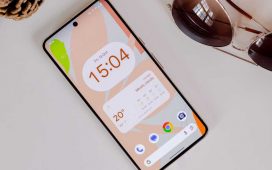Whether you’re new to VR or considering an upgrade from an older headset, the Reverb G2 should appeal.
It works with PCs – it’s a Windows Mixed Reality device – and the headline feature is the high resolution which 2.5x better than the Oculus Rift S.
It isn’t the only high-res HMD (head-mounted device) around, but it’s cheaper than the HTV Vive Pro 2. That has a so-called ‘5K’ display and unless you already have the controllers and base stations and can simply buy the headset on its own, it’ll cost you £1299 /$1399.
The G2 offers 2160×2160 per eye, with a total of 9.3 million pixels and runs at 90Hz. Thanks to inside-out tracking it doesn’t require any base stations: it works just like an Oculus Quest 2.
Features & Design
- Adjustable IPD
- Lenses & earphones designed by Valve
- 6m DisplayPort cable
- 550g (1.2lbs)
When you get the G2 out of its black box first impressions are good. Despite the overwhelmingly plastic finish, it feels well made and there’s thick foam padding around the lenses and headband.

At 550g it doesn’t quite live up to HP’s lightweight claims: even the Oculus Quest 2 with its battery weighs less.
It’s a little front-heavy as you’d expect and there’s no mechanism on the back to quickly tighten or loosen it. Instead you have to deal with three Velcro straps.
At least the headband hinges upwards, which makes it easier to put on, especially if you wear glasses. And unless you have unusually wide frames, they should fit comfortably in the G2 – there’s also enough space your lenses aren’t rubbing against those in the HMD.

Overall, I found the G2 less comfortable than the Rift and Quest, and the thick cable is quite heavy and pulls down on the left-hand side.
The G2 was developed in conjunction with Valve and supports SteamVR, which is a real boon for gamers.
The lens shape is much like the Index, but each one has a resolution of 2160×2160. That’s higher than the 1440×1600 Index lenses, but lower than the Vive Pro 2 (2448×2448 per eye). The G2, though, has the lowest refresh rate at 90Hz: the Index can run at 144Hz, and the Pro 2 at 120Hz.
Field of view is 114 degrees, again lower than the other two at 120° for the Pro 2 and 130° for the Index.

Underneath, you’ll find a slider for adjusting the IPD (interpupillary distance) and on the front and sides four cameras for tracking movement. Previous Windows Mixed Reality (WMR) headsets had only two, which wasn’t really enough for tracking the position of the controllers.
The off-ear headphones are effectively the same as those on the Valve Index, sitting around 10mm away from your ear and being fully adjustable so they sit directly over your ears.
Controllers
One area where the G2 seems less polished is the controllers. They’re an improvement on other WMR offerings and look futuristic when the white LEDs are lit up, but the buttons and joysticks don’t have a great feel to them and some online user reviews complain of the joysticks getting stuck in position.

Personally, I found them comfortable to use and that they were tracked just fine.
Setup
Having been used to an Oculus Rift and with limited experience of WMR headsets, I was surprised how many issues I encountered simply getting the G2 to work.
First you have to install Windows Mixed Reality from the Microsoft Store – it’s not part of Windows 10 by default. Then you have to connect up the hardware: attach the 6m cable to the headset, and plug in the USB-C and DisplayPort connectors at the other end.
That’s not all: the G2 requires its own power supply, which plugs into a small box near the end of the cable. And HP ships a USB-A to USB-C converter in case your PC or laptop doesn’t have one, as well as a USB-C hub with three USB-A ports.

WMR has its own idiosyncrasies, which aren’t really the Reverb’s fault, but things such as using the headset to trace the play area instead of the controllers doesn’t make sense and isn’t as easy.
Unfortunately, I didn’t have an Intel-based PC to test with and quickly discovered why so many users claim the G2 doesn’t play nicely with AMD systems. I used a machine with an X370 motherboard and Ryzen 7 1800X CPU, and found that in some apps and games, the video in the G2 would cut out after a couple of minutes, sometimes temporarily (for a couple of seconds) or permanently.
Audio also cut out, but this was fixed with a firmware update.
The video issues were cured by plugging the headset into the USB-C to USB-A converter, then plugging that into one of the USB 3 ports on the hub and plugging that into a USB-C port on the motherboard.
Performance
Unfortunately, that wasn’t the last of the problems. As regular WMR users will know, headsets often need to be unplugged and re-plugged to get the WMR to detect them.
Then, if you want to play a Steam game such as Half Life: Alyx, you need to fire up SteamVR, which may or may not detect the headset either.
Put simply, I came to expect to spend around 10 minutes getting the G2 working and fitted comfortably to my head before I could actually use it each time. And that’s 10 minutes longer than it takes with an Oculus Rift.
Tracking was the other main problem. It turns out the G2’s cameras – even though there are now four of them compared to two on the original – don’t like working in a restricted space, despite there being no minimum space requirements, and need the right amount of light. Otherwise they simply can’t properly track head movements. I thought this could be specific to sim racing or flight sims where you might be sat at a desk or rig with a steering wheel or flight controller.

But it doesn’t take much searching online to find countless other reports of the same issues. That said, using a larger, well-lit space did mostly fix the tracking issues, but it was still an annoyance as the Rift works fine in the smaller spaces and doesn’t need lots of light.
Most people, of course, will use the G2 in a sensible-sized room suitable for VR apps and games, and should find that tracking is just fine – if not quite as good as with an outside-in system such as the Rift, Index or Vive Pro 2 (which itself is finnicky to get working).
When it is working, the G2 is a revelation. The high resolution – as with the Vive Pro 2 – takes VR to the next level. If you’re used to first-generation VR headset with their screen-door effect and impossible-to-read text, the G2 is like upgrading from standard definition straight to Ultra HD.
I was able to see details I’d never even noticed before in games, and it’s no lie to say you’ll happily go and replay every one of your favourite VR games if you are upgrading from something like an original Oculus Rift. The different in clarity really is night and day.
The drawback is that the sweet spot is very small with the G2. When you’re looking dead ahead, you get that fantastic almost lifelike definition but look to the edges and things become very blurry. This also means you need to spend the time getting the G2 adjusted perfectly when you put it on, as there’s no room for error.
If it moves a bit on your head while you’re moving around, focus will be lost – as will immersion – and you’ll have to stop and put it right as the blurriness makes it too nauseating to carry on.
In terms of image quality, the LCD screens don’t offer the kind of deep blacks that OLED can, but once you’re immersed in whatever you’re doing in VR, you simply won’t think about it.
Sound from the near-field earphones is very good. The fact they sit off your ear allows you to hear your surroundings, which reduces immersion compared to headsets such as the Rift where the earphones press against your ears.
However, that applies only if there’s unrelated sounds going on around you – people talking or a washing machine spinning. As long as it’s quiet, the fact the earphones aren’t pressed against your ears actually improves immersion as the sounds seem more real.
Price & availability
If you’re in the US, the Reverb G2 costs $599 from HP, which is impressive considering the resolution on offer – it’s less than half the price of the Vive Pro 2 full kit. You can also buy it from Amazon.
At the time of review, it was discounted to $499, making it even better value.
In the UK, direct from HP, the Reverb G2 costs £622.80, but at the time of review was out of stock. Elsewhere, due to that lack of availability, prices range from £650 to £950.
See alternative options in our roundup of the best VR headsets.
Verdict
If you’re a gamer, you’ll be tempted by the G2’s resolution, the fact it supports SteamVR and that it has inside-out tracking.
Unfortunately, the reality doesn’t quite match up with expectations. It’s a great headset if you can live with the small sweet spot of the lenses and – ideally – have an Intel-based PC or laptop to drive it.
But if you plan to use it for sim racing or flight sims in a smaller space, it’s certainly not the best choice – and even if you have a large play area for any VR games or apps, the overall experience just isn’t quite as good as you might expect from a next-gen HMD at this price.
It is one of the best WMR headsets around, but most gamers will be better off right now taking the hit in resolution and opting for a Quest 2 which can now be used wirelessly with a PC, or as a standalone headset that doesn’t require a powerful PC to run it.
Specs
HP Reverb G2: Specs
- Dual RGB LCD displays (2.89in diagonal)
- 2160 x 2160 pixels per eye
- 90Hz refresh rate
- 114-degree horizontal FOV
- Valve-designed off-ear headphones
- Integrated microphone
- Bluetooth & USB-C connectivity
- Adjustable IPD (57 – 72mm) with lens distance adjustment
- 6m cable
- Requires Windows Mixed Reality (supports SteamVR)
- Dimensions: 2.95×7.32×3.31in
(75x186x84 mm) - Weight: 1.2lb (550g)














